Business and the Business Environment: Tesco plc Analysis Report
VerifiedAdded on 2021/02/19
|14
|4616
|18
Report
AI Summary
This report provides a comprehensive analysis of Tesco plc, a multinational grocery and merchandise retailer, examining its business environment. It begins by defining different types of organizations, including public, private, and voluntary sectors, and their legal structures, with Tesco being a key example of a private multinational company. The report then explores the size and scope of various organizations, comparing Tesco with NHS and Oxfam, highlighting their missions, visions, and stakeholders. The core of the report delves into the interrelation of various departments within Tesco, such as marketing, finance, and production, and how these interconnections support organizational objectives. Furthermore, it examines the macro-environmental factors affecting Tesco using PESTLE analysis and SWOT analysis, detailing their positive and negative impacts. The report concludes with an analysis of the interplay between strengths, weaknesses, and macro-environmental factors, offering a holistic view of Tesco's strategic position within its business environment.
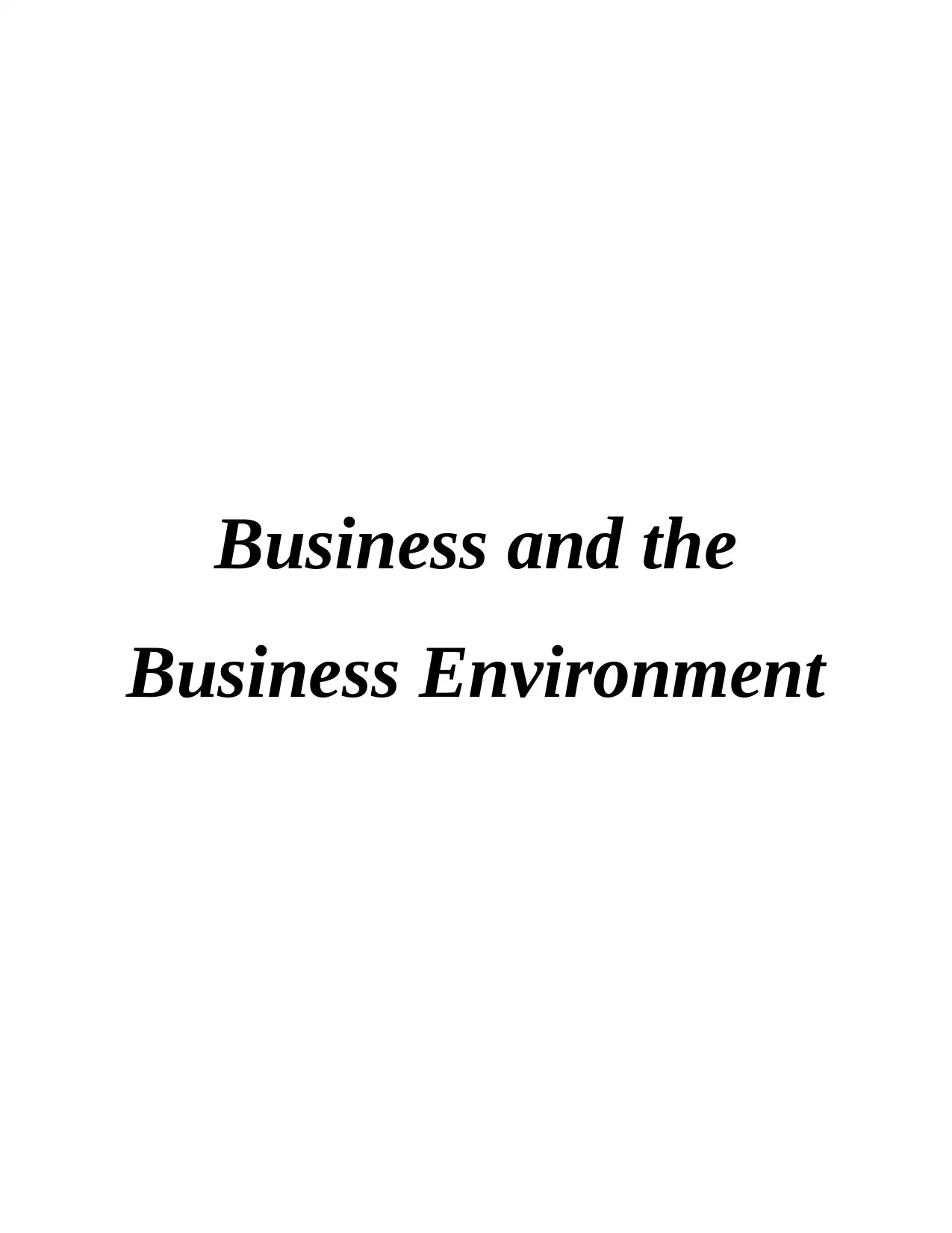
Business and the
Business Environment
Business Environment
Paraphrase This Document
Need a fresh take? Get an instant paraphrase of this document with our AI Paraphraser
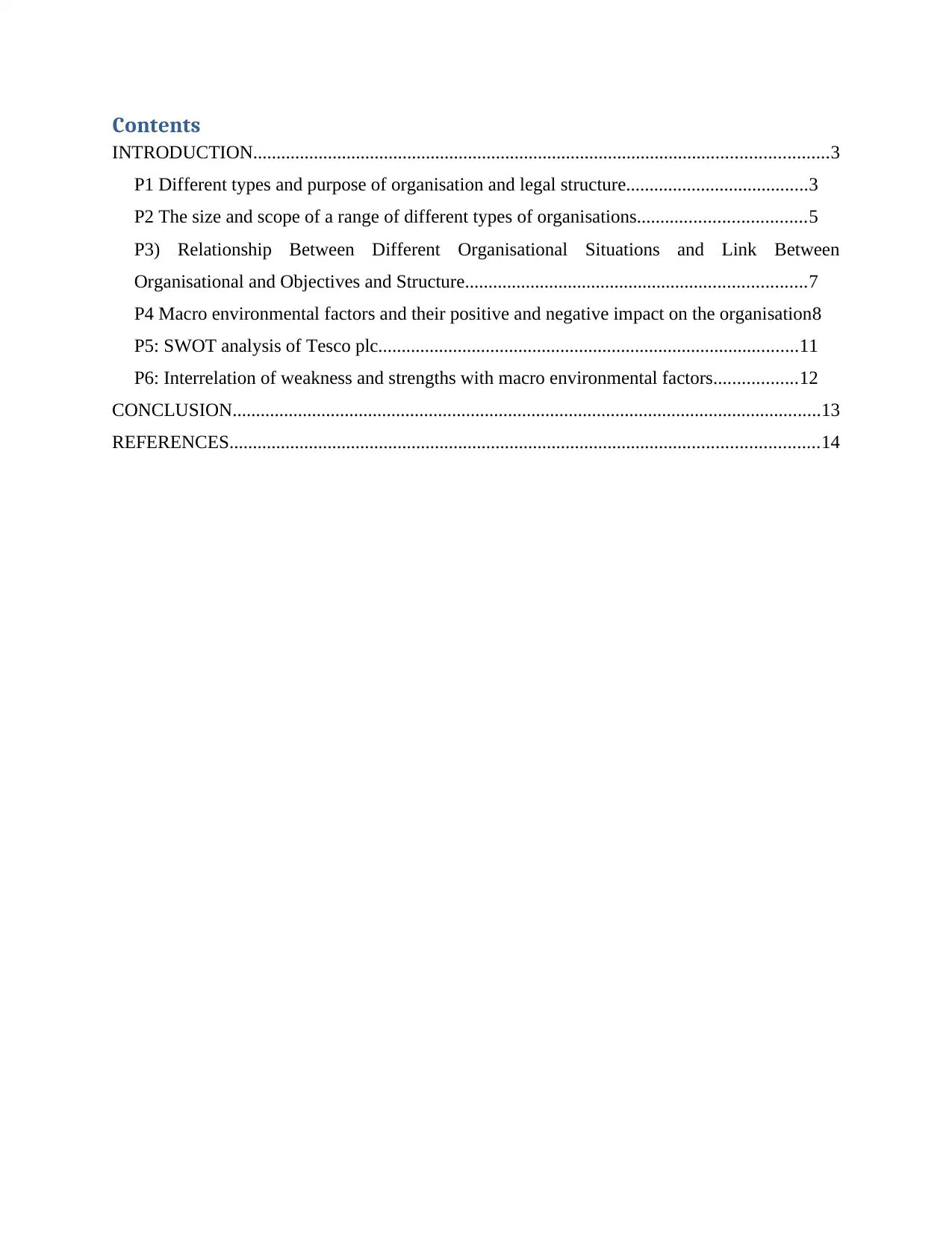
Contents
INTRODUCTION...........................................................................................................................3
P1 Different types and purpose of organisation and legal structure.......................................3
P2 The size and scope of a range of different types of organisations....................................5
P3) Relationship Between Different Organisational Situations and Link Between
Organisational and Objectives and Structure.........................................................................7
P4 Macro environmental factors and their positive and negative impact on the organisation8
P5: SWOT analysis of Tesco plc..........................................................................................11
P6: Interrelation of weakness and strengths with macro environmental factors..................12
CONCLUSION..............................................................................................................................13
REFERENCES..............................................................................................................................14
INTRODUCTION...........................................................................................................................3
P1 Different types and purpose of organisation and legal structure.......................................3
P2 The size and scope of a range of different types of organisations....................................5
P3) Relationship Between Different Organisational Situations and Link Between
Organisational and Objectives and Structure.........................................................................7
P4 Macro environmental factors and their positive and negative impact on the organisation8
P5: SWOT analysis of Tesco plc..........................................................................................11
P6: Interrelation of weakness and strengths with macro environmental factors..................12
CONCLUSION..............................................................................................................................13
REFERENCES..............................................................................................................................14
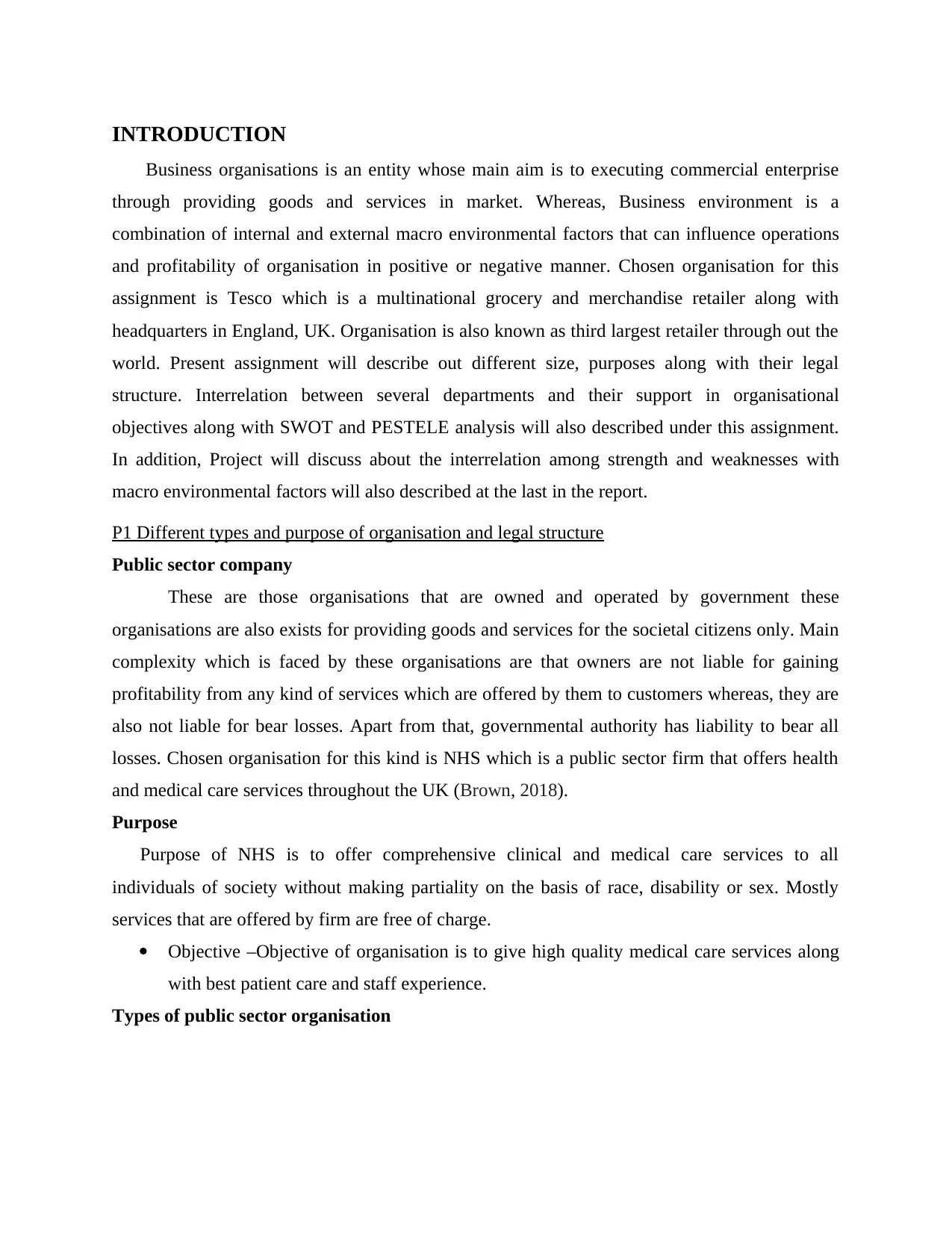
INTRODUCTION
Business organisations is an entity whose main aim is to executing commercial enterprise
through providing goods and services in market. Whereas, Business environment is a
combination of internal and external macro environmental factors that can influence operations
and profitability of organisation in positive or negative manner. Chosen organisation for this
assignment is Tesco which is a multinational grocery and merchandise retailer along with
headquarters in England, UK. Organisation is also known as third largest retailer through out the
world. Present assignment will describe out different size, purposes along with their legal
structure. Interrelation between several departments and their support in organisational
objectives along with SWOT and PESTELE analysis will also described under this assignment.
In addition, Project will discuss about the interrelation among strength and weaknesses with
macro environmental factors will also described at the last in the report.
P1 Different types and purpose of organisation and legal structure
Public sector company
These are those organisations that are owned and operated by government these
organisations are also exists for providing goods and services for the societal citizens only. Main
complexity which is faced by these organisations are that owners are not liable for gaining
profitability from any kind of services which are offered by them to customers whereas, they are
also not liable for bear losses. Apart from that, governmental authority has liability to bear all
losses. Chosen organisation for this kind is NHS which is a public sector firm that offers health
and medical care services throughout the UK (Brown, 2018).
Purpose
Purpose of NHS is to offer comprehensive clinical and medical care services to all
individuals of society without making partiality on the basis of race, disability or sex. Mostly
services that are offered by firm are free of charge.
Objective –Objective of organisation is to give high quality medical care services along
with best patient care and staff experience.
Types of public sector organisation
Business organisations is an entity whose main aim is to executing commercial enterprise
through providing goods and services in market. Whereas, Business environment is a
combination of internal and external macro environmental factors that can influence operations
and profitability of organisation in positive or negative manner. Chosen organisation for this
assignment is Tesco which is a multinational grocery and merchandise retailer along with
headquarters in England, UK. Organisation is also known as third largest retailer through out the
world. Present assignment will describe out different size, purposes along with their legal
structure. Interrelation between several departments and their support in organisational
objectives along with SWOT and PESTELE analysis will also described under this assignment.
In addition, Project will discuss about the interrelation among strength and weaknesses with
macro environmental factors will also described at the last in the report.
P1 Different types and purpose of organisation and legal structure
Public sector company
These are those organisations that are owned and operated by government these
organisations are also exists for providing goods and services for the societal citizens only. Main
complexity which is faced by these organisations are that owners are not liable for gaining
profitability from any kind of services which are offered by them to customers whereas, they are
also not liable for bear losses. Apart from that, governmental authority has liability to bear all
losses. Chosen organisation for this kind is NHS which is a public sector firm that offers health
and medical care services throughout the UK (Brown, 2018).
Purpose
Purpose of NHS is to offer comprehensive clinical and medical care services to all
individuals of society without making partiality on the basis of race, disability or sex. Mostly
services that are offered by firm are free of charge.
Objective –Objective of organisation is to give high quality medical care services along
with best patient care and staff experience.
Types of public sector organisation
⊘ This is a preview!⊘
Do you want full access?
Subscribe today to unlock all pages.

Trusted by 1+ million students worldwide
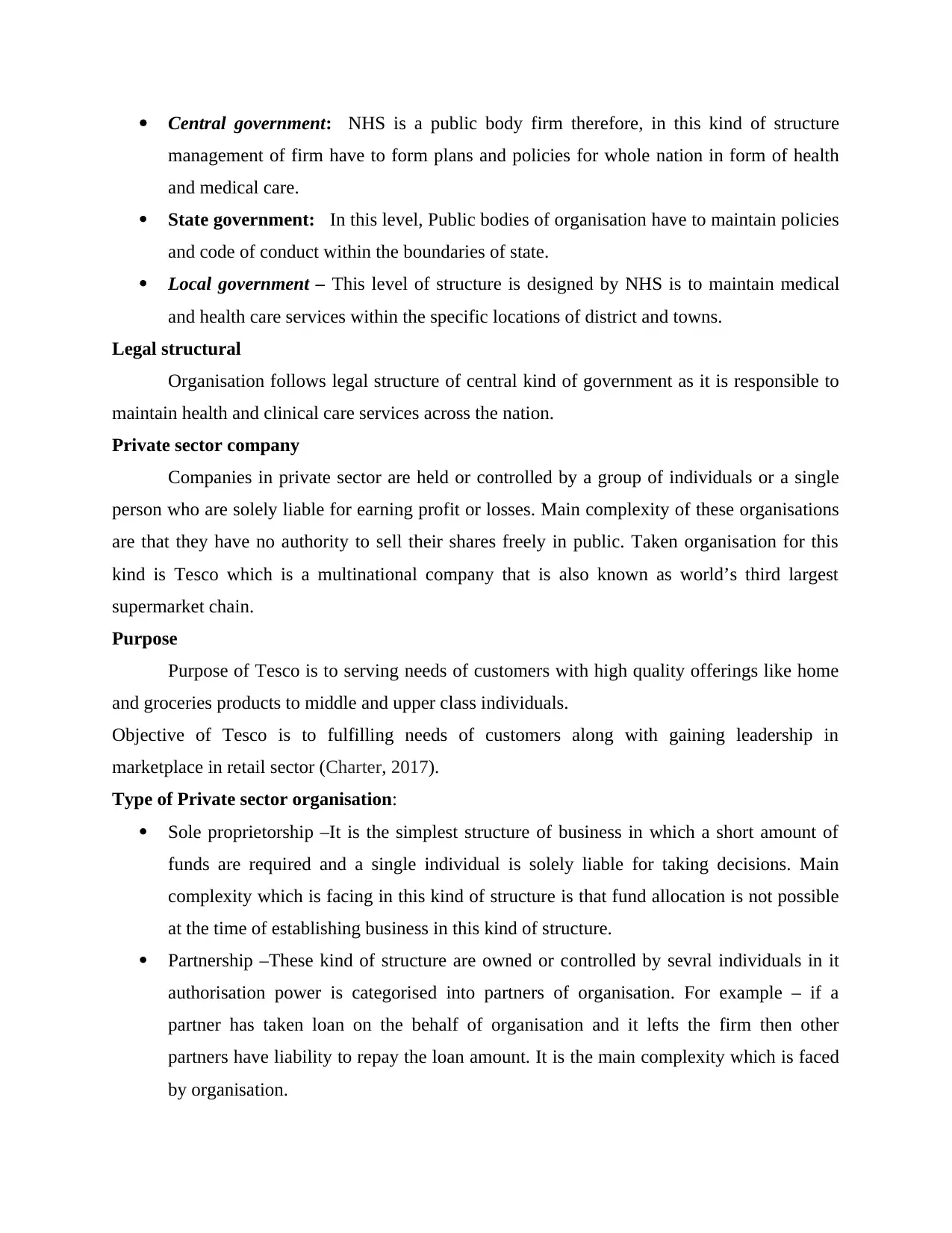
Central government: NHS is a public body firm therefore, in this kind of structure
management of firm have to form plans and policies for whole nation in form of health
and medical care.
State government: In this level, Public bodies of organisation have to maintain policies
and code of conduct within the boundaries of state.
Local government – This level of structure is designed by NHS is to maintain medical
and health care services within the specific locations of district and towns.
Legal structural
Organisation follows legal structure of central kind of government as it is responsible to
maintain health and clinical care services across the nation.
Private sector company
Companies in private sector are held or controlled by a group of individuals or a single
person who are solely liable for earning profit or losses. Main complexity of these organisations
are that they have no authority to sell their shares freely in public. Taken organisation for this
kind is Tesco which is a multinational company that is also known as world’s third largest
supermarket chain.
Purpose
Purpose of Tesco is to serving needs of customers with high quality offerings like home
and groceries products to middle and upper class individuals.
Objective of Tesco is to fulfilling needs of customers along with gaining leadership in
marketplace in retail sector (Charter, 2017).
Type of Private sector organisation:
Sole proprietorship –It is the simplest structure of business in which a short amount of
funds are required and a single individual is solely liable for taking decisions. Main
complexity which is facing in this kind of structure is that fund allocation is not possible
at the time of establishing business in this kind of structure.
Partnership –These kind of structure are owned or controlled by sevral individuals in it
authorisation power is categorised into partners of organisation. For example – if a
partner has taken loan on the behalf of organisation and it lefts the firm then other
partners have liability to repay the loan amount. It is the main complexity which is faced
by organisation.
management of firm have to form plans and policies for whole nation in form of health
and medical care.
State government: In this level, Public bodies of organisation have to maintain policies
and code of conduct within the boundaries of state.
Local government – This level of structure is designed by NHS is to maintain medical
and health care services within the specific locations of district and towns.
Legal structural
Organisation follows legal structure of central kind of government as it is responsible to
maintain health and clinical care services across the nation.
Private sector company
Companies in private sector are held or controlled by a group of individuals or a single
person who are solely liable for earning profit or losses. Main complexity of these organisations
are that they have no authority to sell their shares freely in public. Taken organisation for this
kind is Tesco which is a multinational company that is also known as world’s third largest
supermarket chain.
Purpose
Purpose of Tesco is to serving needs of customers with high quality offerings like home
and groceries products to middle and upper class individuals.
Objective of Tesco is to fulfilling needs of customers along with gaining leadership in
marketplace in retail sector (Charter, 2017).
Type of Private sector organisation:
Sole proprietorship –It is the simplest structure of business in which a short amount of
funds are required and a single individual is solely liable for taking decisions. Main
complexity which is facing in this kind of structure is that fund allocation is not possible
at the time of establishing business in this kind of structure.
Partnership –These kind of structure are owned or controlled by sevral individuals in it
authorisation power is categorised into partners of organisation. For example – if a
partner has taken loan on the behalf of organisation and it lefts the firm then other
partners have liability to repay the loan amount. It is the main complexity which is faced
by organisation.
Paraphrase This Document
Need a fresh take? Get an instant paraphrase of this document with our AI Paraphraser
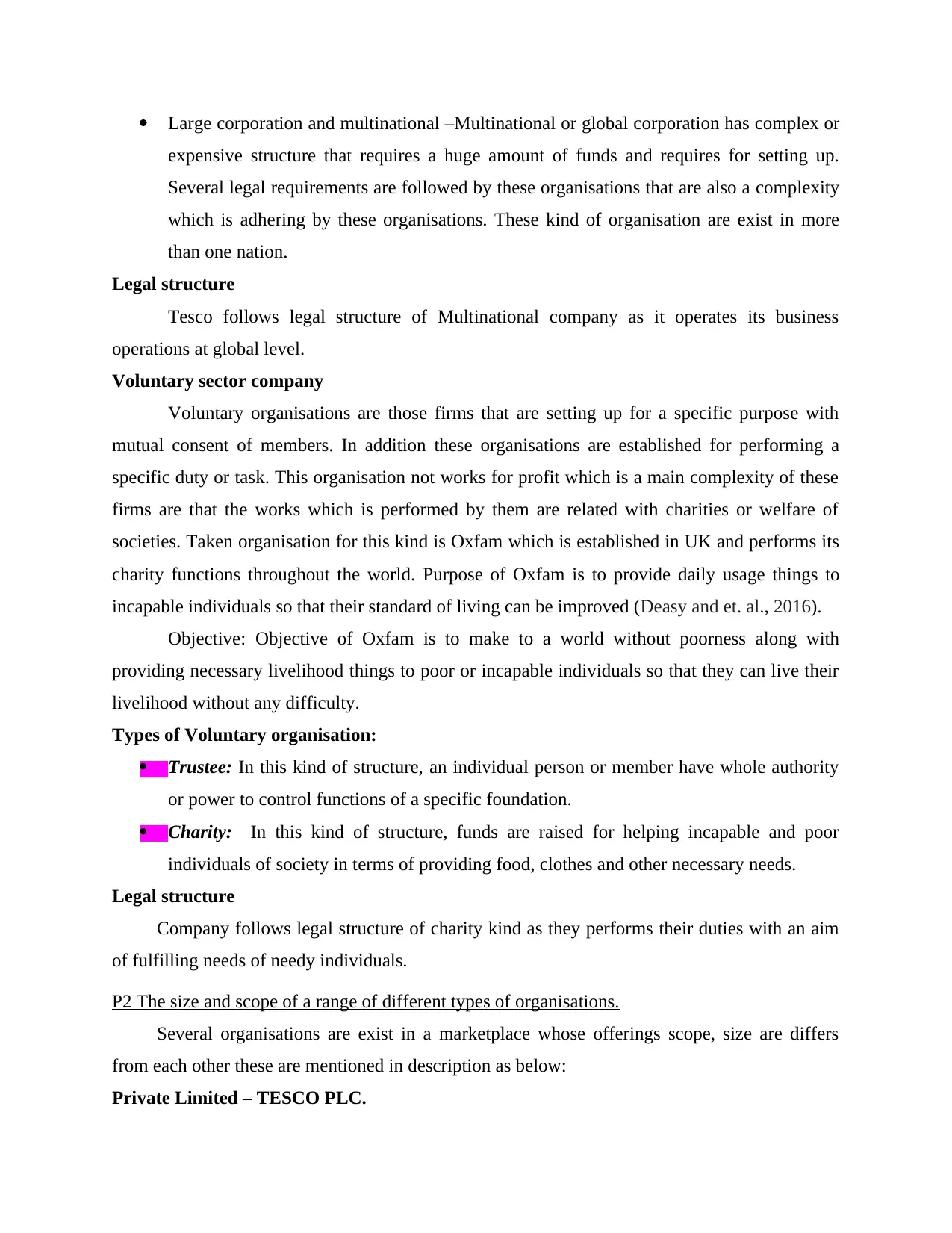
Large corporation and multinational –Multinational or global corporation has complex or
expensive structure that requires a huge amount of funds and requires for setting up.
Several legal requirements are followed by these organisations that are also a complexity
which is adhering by these organisations. These kind of organisation are exist in more
than one nation.
Legal structure
Tesco follows legal structure of Multinational company as it operates its business
operations at global level.
Voluntary sector company
Voluntary organisations are those firms that are setting up for a specific purpose with
mutual consent of members. In addition these organisations are established for performing a
specific duty or task. This organisation not works for profit which is a main complexity of these
firms are that the works which is performed by them are related with charities or welfare of
societies. Taken organisation for this kind is Oxfam which is established in UK and performs its
charity functions throughout the world. Purpose of Oxfam is to provide daily usage things to
incapable individuals so that their standard of living can be improved (Deasy and et. al., 2016).
Objective: Objective of Oxfam is to make to a world without poorness along with
providing necessary livelihood things to poor or incapable individuals so that they can live their
livelihood without any difficulty.
Types of Voluntary organisation:
Trustee: In this kind of structure, an individual person or member have whole authority
or power to control functions of a specific foundation.
Charity: In this kind of structure, funds are raised for helping incapable and poor
individuals of society in terms of providing food, clothes and other necessary needs.
Legal structure
Company follows legal structure of charity kind as they performs their duties with an aim
of fulfilling needs of needy individuals.
P2 The size and scope of a range of different types of organisations.
Several organisations are exist in a marketplace whose offerings scope, size are differs
from each other these are mentioned in description as below:
Private Limited – TESCO PLC.
expensive structure that requires a huge amount of funds and requires for setting up.
Several legal requirements are followed by these organisations that are also a complexity
which is adhering by these organisations. These kind of organisation are exist in more
than one nation.
Legal structure
Tesco follows legal structure of Multinational company as it operates its business
operations at global level.
Voluntary sector company
Voluntary organisations are those firms that are setting up for a specific purpose with
mutual consent of members. In addition these organisations are established for performing a
specific duty or task. This organisation not works for profit which is a main complexity of these
firms are that the works which is performed by them are related with charities or welfare of
societies. Taken organisation for this kind is Oxfam which is established in UK and performs its
charity functions throughout the world. Purpose of Oxfam is to provide daily usage things to
incapable individuals so that their standard of living can be improved (Deasy and et. al., 2016).
Objective: Objective of Oxfam is to make to a world without poorness along with
providing necessary livelihood things to poor or incapable individuals so that they can live their
livelihood without any difficulty.
Types of Voluntary organisation:
Trustee: In this kind of structure, an individual person or member have whole authority
or power to control functions of a specific foundation.
Charity: In this kind of structure, funds are raised for helping incapable and poor
individuals of society in terms of providing food, clothes and other necessary needs.
Legal structure
Company follows legal structure of charity kind as they performs their duties with an aim
of fulfilling needs of needy individuals.
P2 The size and scope of a range of different types of organisations.
Several organisations are exist in a marketplace whose offerings scope, size are differs
from each other these are mentioned in description as below:
Private Limited – TESCO PLC.
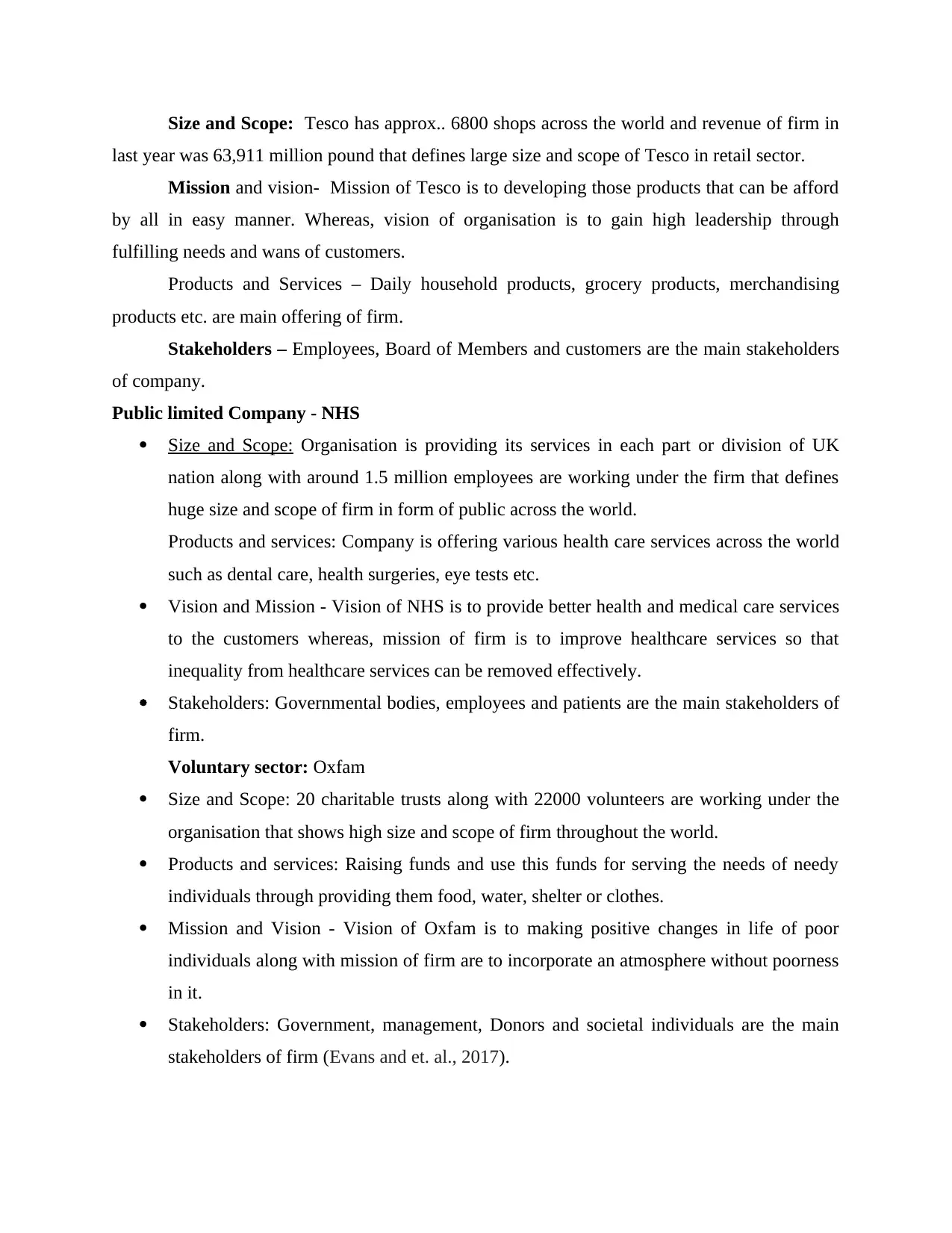
Size and Scope: Tesco has approx.. 6800 shops across the world and revenue of firm in
last year was 63,911 million pound that defines large size and scope of Tesco in retail sector.
Mission and vision- Mission of Tesco is to developing those products that can be afford
by all in easy manner. Whereas, vision of organisation is to gain high leadership through
fulfilling needs and wans of customers.
Products and Services – Daily household products, grocery products, merchandising
products etc. are main offering of firm.
Stakeholders – Employees, Board of Members and customers are the main stakeholders
of company.
Public limited Company - NHS
Size and Scope: Organisation is providing its services in each part or division of UK
nation along with around 1.5 million employees are working under the firm that defines
huge size and scope of firm in form of public across the world.
Products and services: Company is offering various health care services across the world
such as dental care, health surgeries, eye tests etc.
Vision and Mission - Vision of NHS is to provide better health and medical care services
to the customers whereas, mission of firm is to improve healthcare services so that
inequality from healthcare services can be removed effectively.
Stakeholders: Governmental bodies, employees and patients are the main stakeholders of
firm.
Voluntary sector: Oxfam
Size and Scope: 20 charitable trusts along with 22000 volunteers are working under the
organisation that shows high size and scope of firm throughout the world.
Products and services: Raising funds and use this funds for serving the needs of needy
individuals through providing them food, water, shelter or clothes.
Mission and Vision - Vision of Oxfam is to making positive changes in life of poor
individuals along with mission of firm are to incorporate an atmosphere without poorness
in it.
Stakeholders: Government, management, Donors and societal individuals are the main
stakeholders of firm (Evans and et. al., 2017).
last year was 63,911 million pound that defines large size and scope of Tesco in retail sector.
Mission and vision- Mission of Tesco is to developing those products that can be afford
by all in easy manner. Whereas, vision of organisation is to gain high leadership through
fulfilling needs and wans of customers.
Products and Services – Daily household products, grocery products, merchandising
products etc. are main offering of firm.
Stakeholders – Employees, Board of Members and customers are the main stakeholders
of company.
Public limited Company - NHS
Size and Scope: Organisation is providing its services in each part or division of UK
nation along with around 1.5 million employees are working under the firm that defines
huge size and scope of firm in form of public across the world.
Products and services: Company is offering various health care services across the world
such as dental care, health surgeries, eye tests etc.
Vision and Mission - Vision of NHS is to provide better health and medical care services
to the customers whereas, mission of firm is to improve healthcare services so that
inequality from healthcare services can be removed effectively.
Stakeholders: Governmental bodies, employees and patients are the main stakeholders of
firm.
Voluntary sector: Oxfam
Size and Scope: 20 charitable trusts along with 22000 volunteers are working under the
organisation that shows high size and scope of firm throughout the world.
Products and services: Raising funds and use this funds for serving the needs of needy
individuals through providing them food, water, shelter or clothes.
Mission and Vision - Vision of Oxfam is to making positive changes in life of poor
individuals along with mission of firm are to incorporate an atmosphere without poorness
in it.
Stakeholders: Government, management, Donors and societal individuals are the main
stakeholders of firm (Evans and et. al., 2017).
⊘ This is a preview!⊘
Do you want full access?
Subscribe today to unlock all pages.

Trusted by 1+ million students worldwide
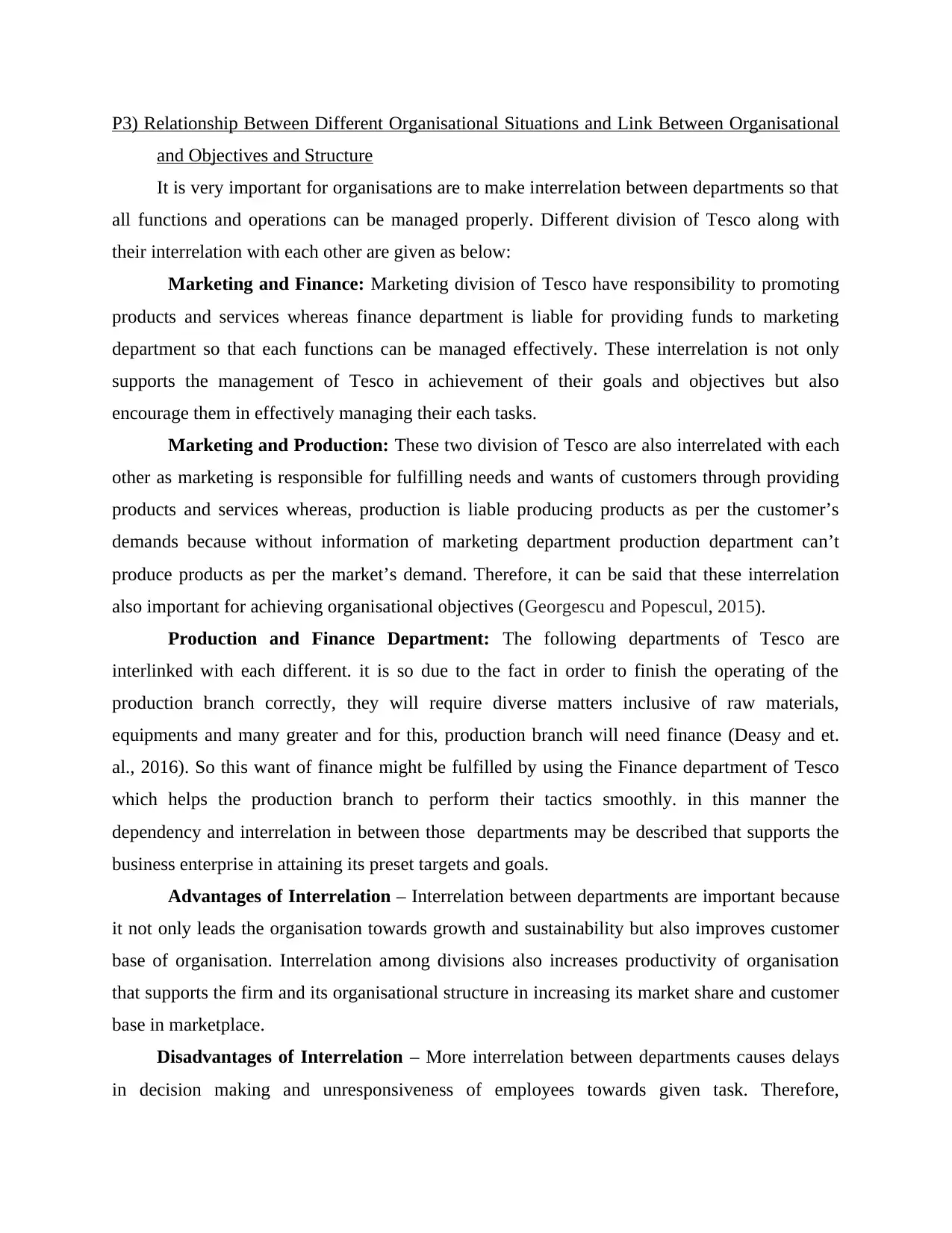
P3) Relationship Between Different Organisational Situations and Link Between Organisational
and Objectives and Structure
It is very important for organisations are to make interrelation between departments so that
all functions and operations can be managed properly. Different division of Tesco along with
their interrelation with each other are given as below:
Marketing and Finance: Marketing division of Tesco have responsibility to promoting
products and services whereas finance department is liable for providing funds to marketing
department so that each functions can be managed effectively. These interrelation is not only
supports the management of Tesco in achievement of their goals and objectives but also
encourage them in effectively managing their each tasks.
Marketing and Production: These two division of Tesco are also interrelated with each
other as marketing is responsible for fulfilling needs and wants of customers through providing
products and services whereas, production is liable producing products as per the customer’s
demands because without information of marketing department production department can’t
produce products as per the market’s demand. Therefore, it can be said that these interrelation
also important for achieving organisational objectives (Georgescu and Popescul, 2015).
Production and Finance Department: The following departments of Tesco are
interlinked with each different. it is so due to the fact in order to finish the operating of the
production branch correctly, they will require diverse matters inclusive of raw materials,
equipments and many greater and for this, production branch will need finance (Deasy and et.
al., 2016). So this want of finance might be fulfilled by using the Finance department of Tesco
which helps the production branch to perform their tactics smoothly. in this manner the
dependency and interrelation in between those departments may be described that supports the
business enterprise in attaining its preset targets and goals.
Advantages of Interrelation – Interrelation between departments are important because
it not only leads the organisation towards growth and sustainability but also improves customer
base of organisation. Interrelation among divisions also increases productivity of organisation
that supports the firm and its organisational structure in increasing its market share and customer
base in marketplace.
Disadvantages of Interrelation – More interrelation between departments causes delays
in decision making and unresponsiveness of employees towards given task. Therefore,
and Objectives and Structure
It is very important for organisations are to make interrelation between departments so that
all functions and operations can be managed properly. Different division of Tesco along with
their interrelation with each other are given as below:
Marketing and Finance: Marketing division of Tesco have responsibility to promoting
products and services whereas finance department is liable for providing funds to marketing
department so that each functions can be managed effectively. These interrelation is not only
supports the management of Tesco in achievement of their goals and objectives but also
encourage them in effectively managing their each tasks.
Marketing and Production: These two division of Tesco are also interrelated with each
other as marketing is responsible for fulfilling needs and wants of customers through providing
products and services whereas, production is liable producing products as per the customer’s
demands because without information of marketing department production department can’t
produce products as per the market’s demand. Therefore, it can be said that these interrelation
also important for achieving organisational objectives (Georgescu and Popescul, 2015).
Production and Finance Department: The following departments of Tesco are
interlinked with each different. it is so due to the fact in order to finish the operating of the
production branch correctly, they will require diverse matters inclusive of raw materials,
equipments and many greater and for this, production branch will need finance (Deasy and et.
al., 2016). So this want of finance might be fulfilled by using the Finance department of Tesco
which helps the production branch to perform their tactics smoothly. in this manner the
dependency and interrelation in between those departments may be described that supports the
business enterprise in attaining its preset targets and goals.
Advantages of Interrelation – Interrelation between departments are important because
it not only leads the organisation towards growth and sustainability but also improves customer
base of organisation. Interrelation among divisions also increases productivity of organisation
that supports the firm and its organisational structure in increasing its market share and customer
base in marketplace.
Disadvantages of Interrelation – More interrelation between departments causes delays
in decision making and unresponsiveness of employees towards given task. Therefore,
Paraphrase This Document
Need a fresh take? Get an instant paraphrase of this document with our AI Paraphraser
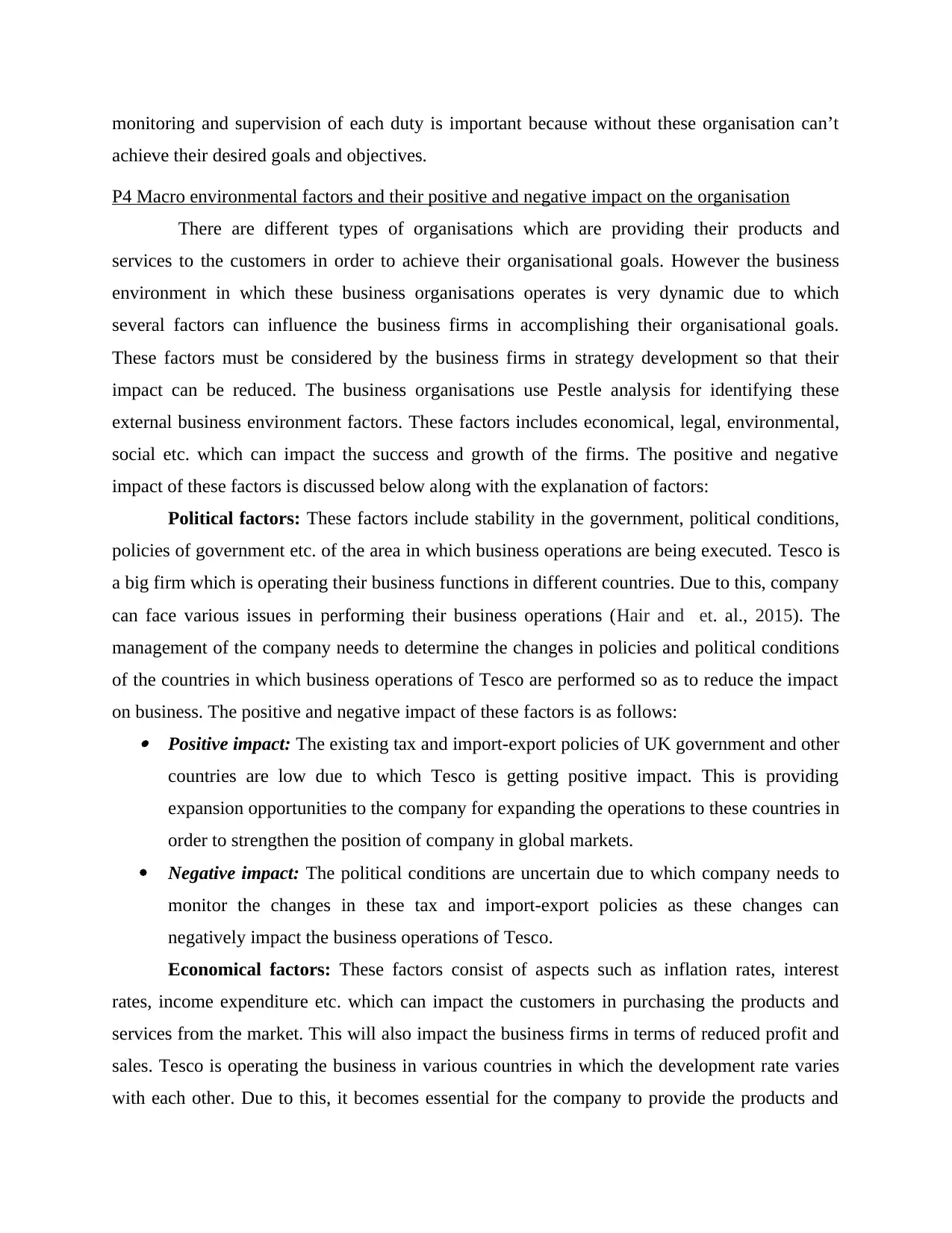
monitoring and supervision of each duty is important because without these organisation can’t
achieve their desired goals and objectives.
P4 Macro environmental factors and their positive and negative impact on the organisation
There are different types of organisations which are providing their products and
services to the customers in order to achieve their organisational goals. However the business
environment in which these business organisations operates is very dynamic due to which
several factors can influence the business firms in accomplishing their organisational goals.
These factors must be considered by the business firms in strategy development so that their
impact can be reduced. The business organisations use Pestle analysis for identifying these
external business environment factors. These factors includes economical, legal, environmental,
social etc. which can impact the success and growth of the firms. The positive and negative
impact of these factors is discussed below along with the explanation of factors:
Political factors: These factors include stability in the government, political conditions,
policies of government etc. of the area in which business operations are being executed. Tesco is
a big firm which is operating their business functions in different countries. Due to this, company
can face various issues in performing their business operations (Hair and et. al., 2015). The
management of the company needs to determine the changes in policies and political conditions
of the countries in which business operations of Tesco are performed so as to reduce the impact
on business. The positive and negative impact of these factors is as follows: Positive impact: The existing tax and import-export policies of UK government and other
countries are low due to which Tesco is getting positive impact. This is providing
expansion opportunities to the company for expanding the operations to these countries in
order to strengthen the position of company in global markets.
Negative impact: The political conditions are uncertain due to which company needs to
monitor the changes in these tax and import-export policies as these changes can
negatively impact the business operations of Tesco.
Economical factors: These factors consist of aspects such as inflation rates, interest
rates, income expenditure etc. which can impact the customers in purchasing the products and
services from the market. This will also impact the business firms in terms of reduced profit and
sales. Tesco is operating the business in various countries in which the development rate varies
with each other. Due to this, it becomes essential for the company to provide the products and
achieve their desired goals and objectives.
P4 Macro environmental factors and their positive and negative impact on the organisation
There are different types of organisations which are providing their products and
services to the customers in order to achieve their organisational goals. However the business
environment in which these business organisations operates is very dynamic due to which
several factors can influence the business firms in accomplishing their organisational goals.
These factors must be considered by the business firms in strategy development so that their
impact can be reduced. The business organisations use Pestle analysis for identifying these
external business environment factors. These factors includes economical, legal, environmental,
social etc. which can impact the success and growth of the firms. The positive and negative
impact of these factors is discussed below along with the explanation of factors:
Political factors: These factors include stability in the government, political conditions,
policies of government etc. of the area in which business operations are being executed. Tesco is
a big firm which is operating their business functions in different countries. Due to this, company
can face various issues in performing their business operations (Hair and et. al., 2015). The
management of the company needs to determine the changes in policies and political conditions
of the countries in which business operations of Tesco are performed so as to reduce the impact
on business. The positive and negative impact of these factors is as follows: Positive impact: The existing tax and import-export policies of UK government and other
countries are low due to which Tesco is getting positive impact. This is providing
expansion opportunities to the company for expanding the operations to these countries in
order to strengthen the position of company in global markets.
Negative impact: The political conditions are uncertain due to which company needs to
monitor the changes in these tax and import-export policies as these changes can
negatively impact the business operations of Tesco.
Economical factors: These factors consist of aspects such as inflation rates, interest
rates, income expenditure etc. which can impact the customers in purchasing the products and
services from the market. This will also impact the business firms in terms of reduced profit and
sales. Tesco is operating the business in various countries in which the development rate varies
with each other. Due to this, it becomes essential for the company to provide the products and
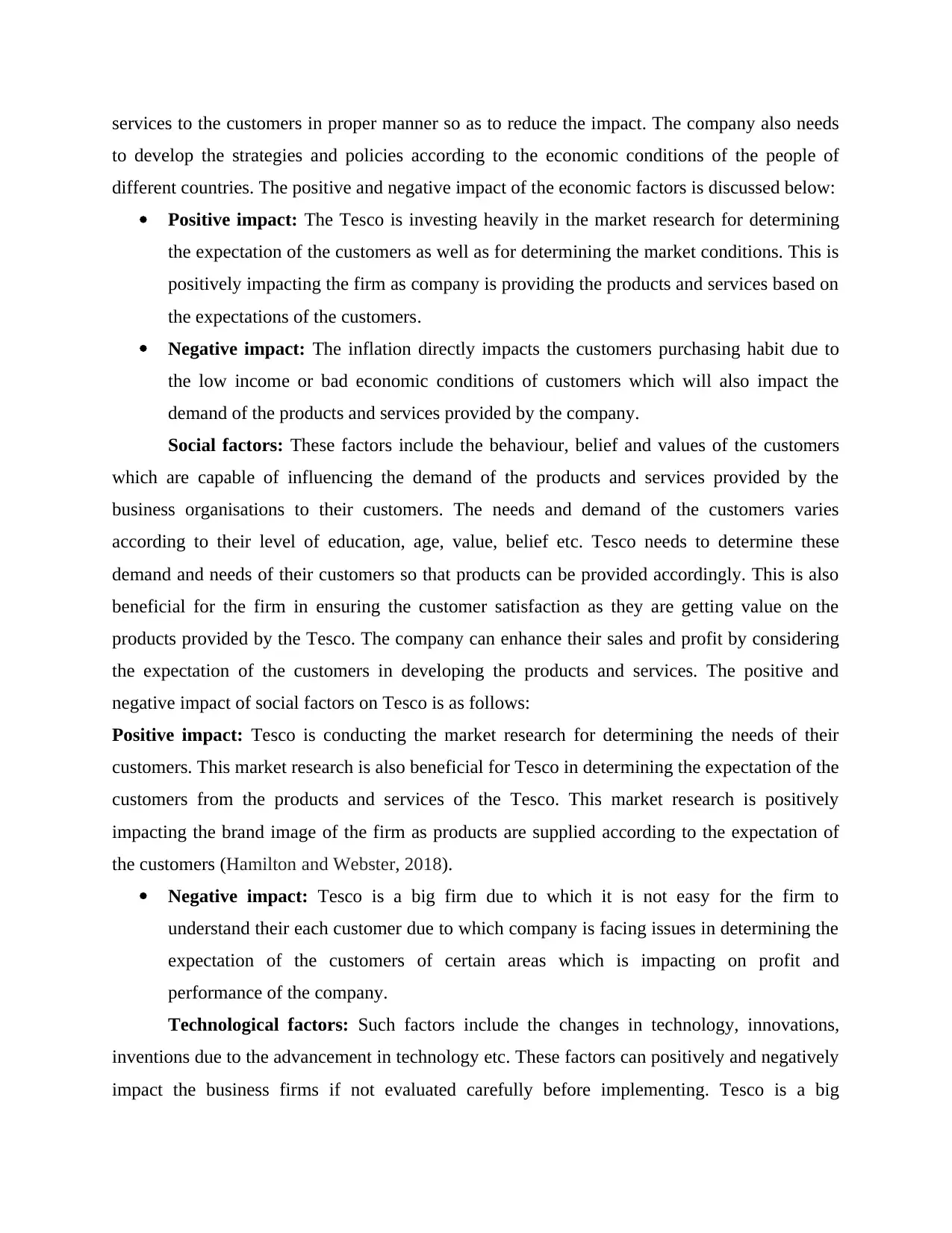
services to the customers in proper manner so as to reduce the impact. The company also needs
to develop the strategies and policies according to the economic conditions of the people of
different countries. The positive and negative impact of the economic factors is discussed below:
Positive impact: The Tesco is investing heavily in the market research for determining
the expectation of the customers as well as for determining the market conditions. This is
positively impacting the firm as company is providing the products and services based on
the expectations of the customers.
Negative impact: The inflation directly impacts the customers purchasing habit due to
the low income or bad economic conditions of customers which will also impact the
demand of the products and services provided by the company.
Social factors: These factors include the behaviour, belief and values of the customers
which are capable of influencing the demand of the products and services provided by the
business organisations to their customers. The needs and demand of the customers varies
according to their level of education, age, value, belief etc. Tesco needs to determine these
demand and needs of their customers so that products can be provided accordingly. This is also
beneficial for the firm in ensuring the customer satisfaction as they are getting value on the
products provided by the Tesco. The company can enhance their sales and profit by considering
the expectation of the customers in developing the products and services. The positive and
negative impact of social factors on Tesco is as follows:
Positive impact: Tesco is conducting the market research for determining the needs of their
customers. This market research is also beneficial for Tesco in determining the expectation of the
customers from the products and services of the Tesco. This market research is positively
impacting the brand image of the firm as products are supplied according to the expectation of
the customers (Hamilton and Webster, 2018).
Negative impact: Tesco is a big firm due to which it is not easy for the firm to
understand their each customer due to which company is facing issues in determining the
expectation of the customers of certain areas which is impacting on profit and
performance of the company.
Technological factors: Such factors include the changes in technology, innovations,
inventions due to the advancement in technology etc. These factors can positively and negatively
impact the business firms if not evaluated carefully before implementing. Tesco is a big
to develop the strategies and policies according to the economic conditions of the people of
different countries. The positive and negative impact of the economic factors is discussed below:
Positive impact: The Tesco is investing heavily in the market research for determining
the expectation of the customers as well as for determining the market conditions. This is
positively impacting the firm as company is providing the products and services based on
the expectations of the customers.
Negative impact: The inflation directly impacts the customers purchasing habit due to
the low income or bad economic conditions of customers which will also impact the
demand of the products and services provided by the company.
Social factors: These factors include the behaviour, belief and values of the customers
which are capable of influencing the demand of the products and services provided by the
business organisations to their customers. The needs and demand of the customers varies
according to their level of education, age, value, belief etc. Tesco needs to determine these
demand and needs of their customers so that products can be provided accordingly. This is also
beneficial for the firm in ensuring the customer satisfaction as they are getting value on the
products provided by the Tesco. The company can enhance their sales and profit by considering
the expectation of the customers in developing the products and services. The positive and
negative impact of social factors on Tesco is as follows:
Positive impact: Tesco is conducting the market research for determining the needs of their
customers. This market research is also beneficial for Tesco in determining the expectation of the
customers from the products and services of the Tesco. This market research is positively
impacting the brand image of the firm as products are supplied according to the expectation of
the customers (Hamilton and Webster, 2018).
Negative impact: Tesco is a big firm due to which it is not easy for the firm to
understand their each customer due to which company is facing issues in determining the
expectation of the customers of certain areas which is impacting on profit and
performance of the company.
Technological factors: Such factors include the changes in technology, innovations,
inventions due to the advancement in technology etc. These factors can positively and negatively
impact the business firms if not evaluated carefully before implementing. Tesco is a big
⊘ This is a preview!⊘
Do you want full access?
Subscribe today to unlock all pages.

Trusted by 1+ million students worldwide
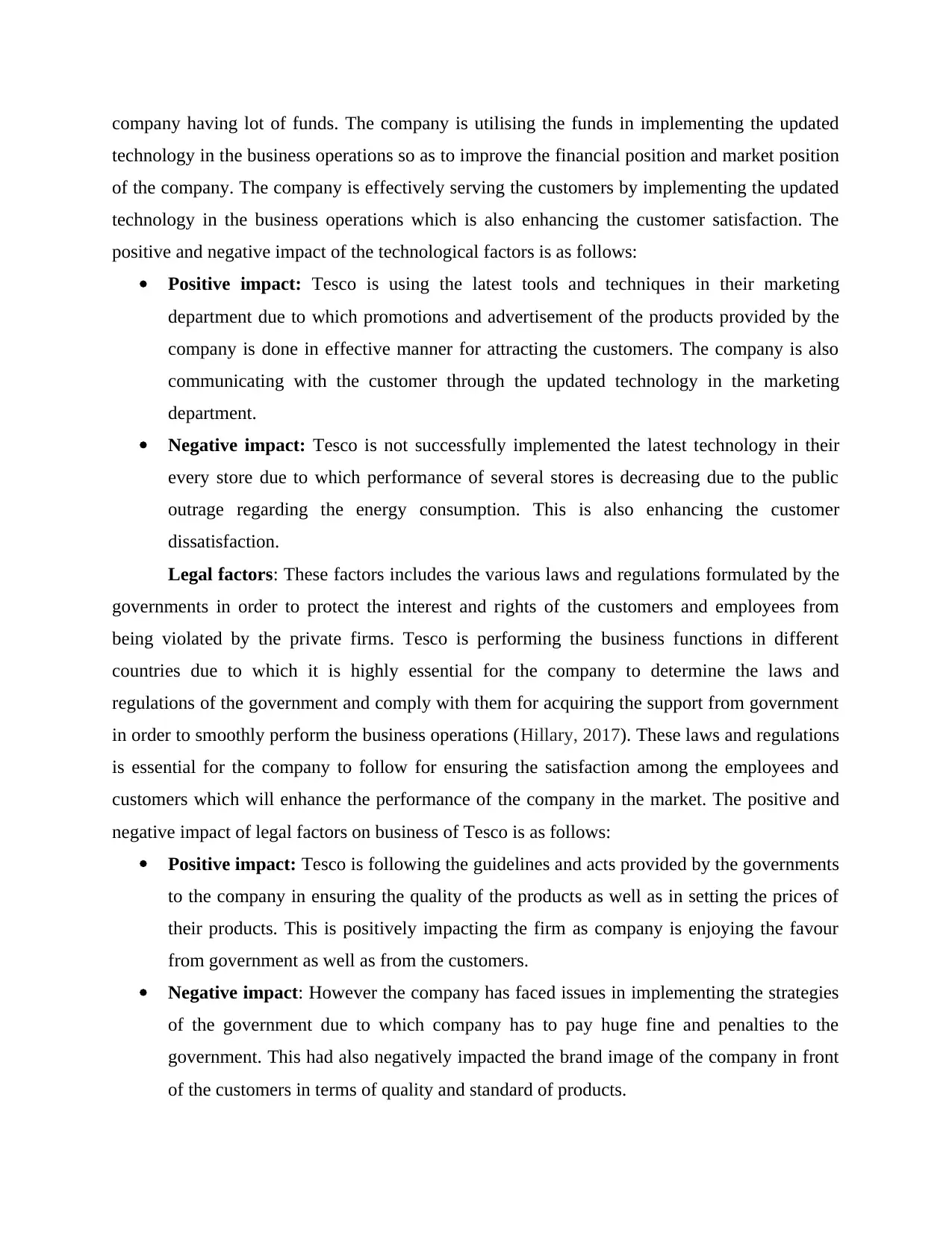
company having lot of funds. The company is utilising the funds in implementing the updated
technology in the business operations so as to improve the financial position and market position
of the company. The company is effectively serving the customers by implementing the updated
technology in the business operations which is also enhancing the customer satisfaction. The
positive and negative impact of the technological factors is as follows:
Positive impact: Tesco is using the latest tools and techniques in their marketing
department due to which promotions and advertisement of the products provided by the
company is done in effective manner for attracting the customers. The company is also
communicating with the customer through the updated technology in the marketing
department.
Negative impact: Tesco is not successfully implemented the latest technology in their
every store due to which performance of several stores is decreasing due to the public
outrage regarding the energy consumption. This is also enhancing the customer
dissatisfaction.
Legal factors: These factors includes the various laws and regulations formulated by the
governments in order to protect the interest and rights of the customers and employees from
being violated by the private firms. Tesco is performing the business functions in different
countries due to which it is highly essential for the company to determine the laws and
regulations of the government and comply with them for acquiring the support from government
in order to smoothly perform the business operations (Hillary, 2017). These laws and regulations
is essential for the company to follow for ensuring the satisfaction among the employees and
customers which will enhance the performance of the company in the market. The positive and
negative impact of legal factors on business of Tesco is as follows:
Positive impact: Tesco is following the guidelines and acts provided by the governments
to the company in ensuring the quality of the products as well as in setting the prices of
their products. This is positively impacting the firm as company is enjoying the favour
from government as well as from the customers.
Negative impact: However the company has faced issues in implementing the strategies
of the government due to which company has to pay huge fine and penalties to the
government. This had also negatively impacted the brand image of the company in front
of the customers in terms of quality and standard of products.
technology in the business operations so as to improve the financial position and market position
of the company. The company is effectively serving the customers by implementing the updated
technology in the business operations which is also enhancing the customer satisfaction. The
positive and negative impact of the technological factors is as follows:
Positive impact: Tesco is using the latest tools and techniques in their marketing
department due to which promotions and advertisement of the products provided by the
company is done in effective manner for attracting the customers. The company is also
communicating with the customer through the updated technology in the marketing
department.
Negative impact: Tesco is not successfully implemented the latest technology in their
every store due to which performance of several stores is decreasing due to the public
outrage regarding the energy consumption. This is also enhancing the customer
dissatisfaction.
Legal factors: These factors includes the various laws and regulations formulated by the
governments in order to protect the interest and rights of the customers and employees from
being violated by the private firms. Tesco is performing the business functions in different
countries due to which it is highly essential for the company to determine the laws and
regulations of the government and comply with them for acquiring the support from government
in order to smoothly perform the business operations (Hillary, 2017). These laws and regulations
is essential for the company to follow for ensuring the satisfaction among the employees and
customers which will enhance the performance of the company in the market. The positive and
negative impact of legal factors on business of Tesco is as follows:
Positive impact: Tesco is following the guidelines and acts provided by the governments
to the company in ensuring the quality of the products as well as in setting the prices of
their products. This is positively impacting the firm as company is enjoying the favour
from government as well as from the customers.
Negative impact: However the company has faced issues in implementing the strategies
of the government due to which company has to pay huge fine and penalties to the
government. This had also negatively impacted the brand image of the company in front
of the customers in terms of quality and standard of products.
Paraphrase This Document
Need a fresh take? Get an instant paraphrase of this document with our AI Paraphraser
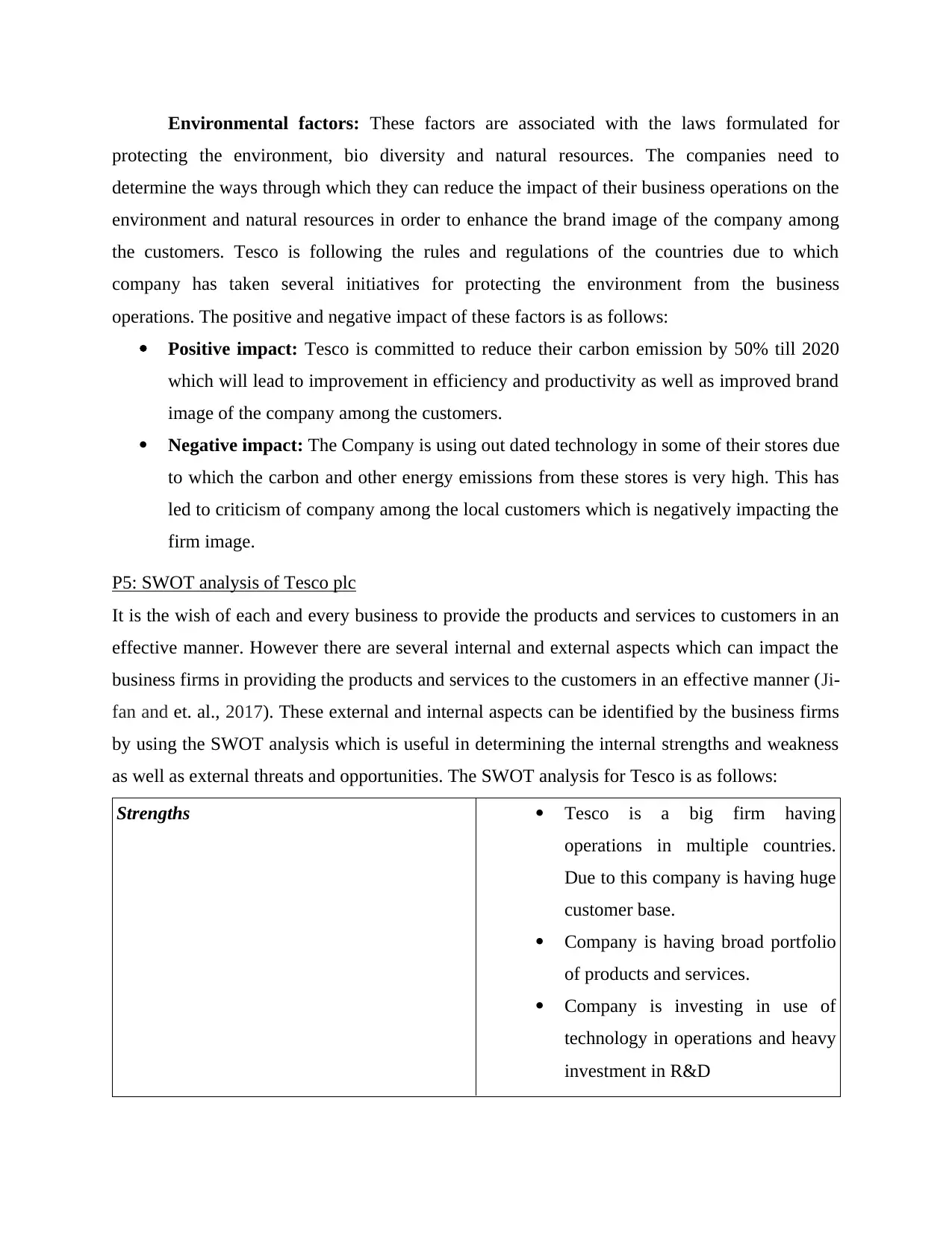
Environmental factors: These factors are associated with the laws formulated for
protecting the environment, bio diversity and natural resources. The companies need to
determine the ways through which they can reduce the impact of their business operations on the
environment and natural resources in order to enhance the brand image of the company among
the customers. Tesco is following the rules and regulations of the countries due to which
company has taken several initiatives for protecting the environment from the business
operations. The positive and negative impact of these factors is as follows:
Positive impact: Tesco is committed to reduce their carbon emission by 50% till 2020
which will lead to improvement in efficiency and productivity as well as improved brand
image of the company among the customers.
Negative impact: The Company is using out dated technology in some of their stores due
to which the carbon and other energy emissions from these stores is very high. This has
led to criticism of company among the local customers which is negatively impacting the
firm image.
P5: SWOT analysis of Tesco plc
It is the wish of each and every business to provide the products and services to customers in an
effective manner. However there are several internal and external aspects which can impact the
business firms in providing the products and services to the customers in an effective manner (Ji-
fan and et. al., 2017). These external and internal aspects can be identified by the business firms
by using the SWOT analysis which is useful in determining the internal strengths and weakness
as well as external threats and opportunities. The SWOT analysis for Tesco is as follows:
Strengths Tesco is a big firm having
operations in multiple countries.
Due to this company is having huge
customer base.
Company is having broad portfolio
of products and services.
Company is investing in use of
technology in operations and heavy
investment in R&D
protecting the environment, bio diversity and natural resources. The companies need to
determine the ways through which they can reduce the impact of their business operations on the
environment and natural resources in order to enhance the brand image of the company among
the customers. Tesco is following the rules and regulations of the countries due to which
company has taken several initiatives for protecting the environment from the business
operations. The positive and negative impact of these factors is as follows:
Positive impact: Tesco is committed to reduce their carbon emission by 50% till 2020
which will lead to improvement in efficiency and productivity as well as improved brand
image of the company among the customers.
Negative impact: The Company is using out dated technology in some of their stores due
to which the carbon and other energy emissions from these stores is very high. This has
led to criticism of company among the local customers which is negatively impacting the
firm image.
P5: SWOT analysis of Tesco plc
It is the wish of each and every business to provide the products and services to customers in an
effective manner. However there are several internal and external aspects which can impact the
business firms in providing the products and services to the customers in an effective manner (Ji-
fan and et. al., 2017). These external and internal aspects can be identified by the business firms
by using the SWOT analysis which is useful in determining the internal strengths and weakness
as well as external threats and opportunities. The SWOT analysis for Tesco is as follows:
Strengths Tesco is a big firm having
operations in multiple countries.
Due to this company is having huge
customer base.
Company is having broad portfolio
of products and services.
Company is investing in use of
technology in operations and heavy
investment in R&D
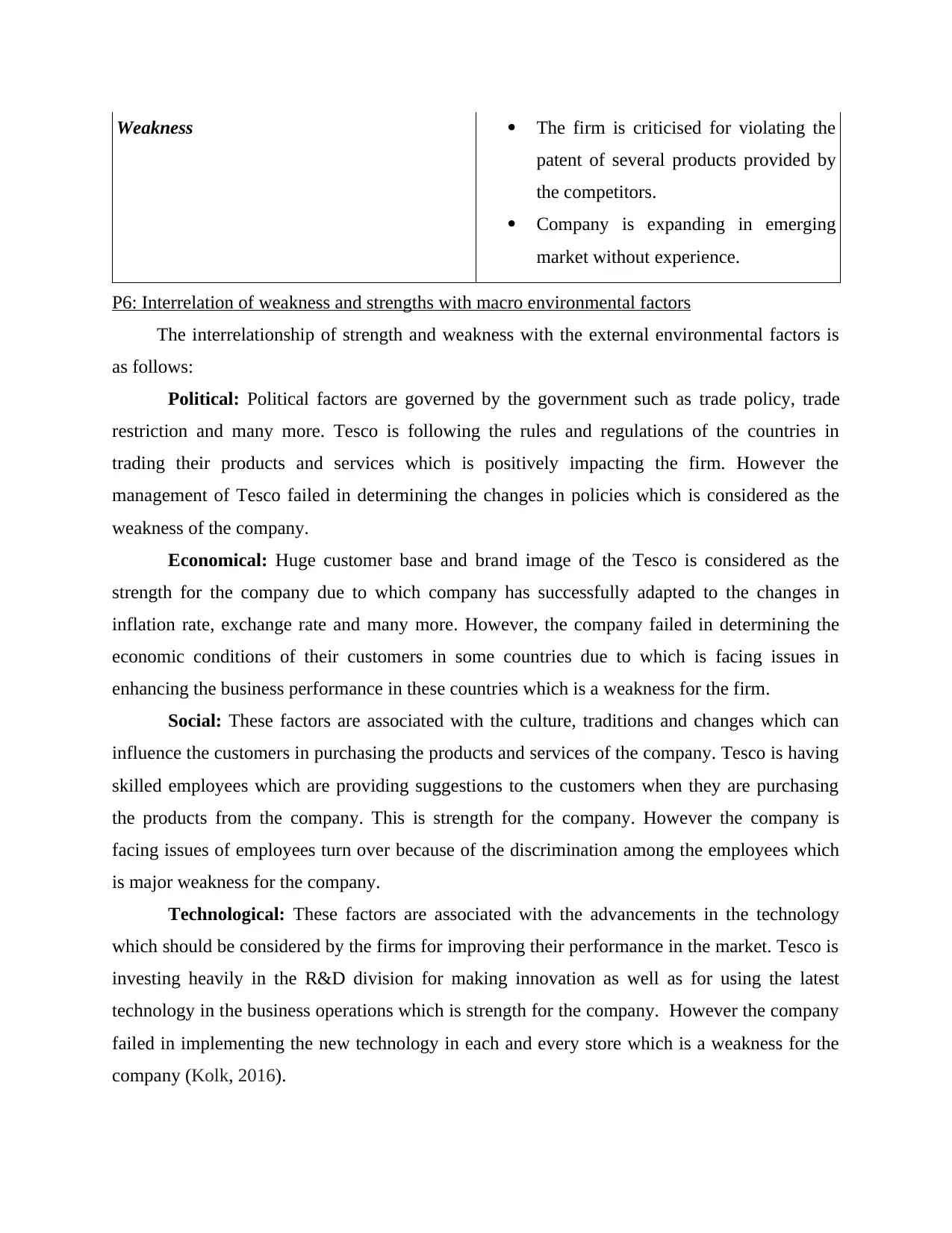
Weakness The firm is criticised for violating the
patent of several products provided by
the competitors.
Company is expanding in emerging
market without experience.
P6: Interrelation of weakness and strengths with macro environmental factors
The interrelationship of strength and weakness with the external environmental factors is
as follows:
Political: Political factors are governed by the government such as trade policy, trade
restriction and many more. Tesco is following the rules and regulations of the countries in
trading their products and services which is positively impacting the firm. However the
management of Tesco failed in determining the changes in policies which is considered as the
weakness of the company.
Economical: Huge customer base and brand image of the Tesco is considered as the
strength for the company due to which company has successfully adapted to the changes in
inflation rate, exchange rate and many more. However, the company failed in determining the
economic conditions of their customers in some countries due to which is facing issues in
enhancing the business performance in these countries which is a weakness for the firm.
Social: These factors are associated with the culture, traditions and changes which can
influence the customers in purchasing the products and services of the company. Tesco is having
skilled employees which are providing suggestions to the customers when they are purchasing
the products from the company. This is strength for the company. However the company is
facing issues of employees turn over because of the discrimination among the employees which
is major weakness for the company.
Technological: These factors are associated with the advancements in the technology
which should be considered by the firms for improving their performance in the market. Tesco is
investing heavily in the R&D division for making innovation as well as for using the latest
technology in the business operations which is strength for the company. However the company
failed in implementing the new technology in each and every store which is a weakness for the
company (Kolk, 2016).
patent of several products provided by
the competitors.
Company is expanding in emerging
market without experience.
P6: Interrelation of weakness and strengths with macro environmental factors
The interrelationship of strength and weakness with the external environmental factors is
as follows:
Political: Political factors are governed by the government such as trade policy, trade
restriction and many more. Tesco is following the rules and regulations of the countries in
trading their products and services which is positively impacting the firm. However the
management of Tesco failed in determining the changes in policies which is considered as the
weakness of the company.
Economical: Huge customer base and brand image of the Tesco is considered as the
strength for the company due to which company has successfully adapted to the changes in
inflation rate, exchange rate and many more. However, the company failed in determining the
economic conditions of their customers in some countries due to which is facing issues in
enhancing the business performance in these countries which is a weakness for the firm.
Social: These factors are associated with the culture, traditions and changes which can
influence the customers in purchasing the products and services of the company. Tesco is having
skilled employees which are providing suggestions to the customers when they are purchasing
the products from the company. This is strength for the company. However the company is
facing issues of employees turn over because of the discrimination among the employees which
is major weakness for the company.
Technological: These factors are associated with the advancements in the technology
which should be considered by the firms for improving their performance in the market. Tesco is
investing heavily in the R&D division for making innovation as well as for using the latest
technology in the business operations which is strength for the company. However the company
failed in implementing the new technology in each and every store which is a weakness for the
company (Kolk, 2016).
⊘ This is a preview!⊘
Do you want full access?
Subscribe today to unlock all pages.

Trusted by 1+ million students worldwide
1 out of 14
Related Documents
Your All-in-One AI-Powered Toolkit for Academic Success.
+13062052269
info@desklib.com
Available 24*7 on WhatsApp / Email
![[object Object]](/_next/static/media/star-bottom.7253800d.svg)
Unlock your academic potential
Copyright © 2020–2025 A2Z Services. All Rights Reserved. Developed and managed by ZUCOL.





